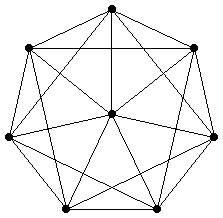
Paul Erdös, famous for offering cash awards for unsolved problems, offered $100 for the solution of the following problem:
Let f(c,a,b) denote the smallest integer n for which there is a graph G with n vertices with the properties that: 1) any edge coloring in c colors contains a monochromatic copy of Ka, and 2) G contains no Kb. Prove or disprove f(2,3,4) < 106.
The best known upper bound is f(2,3,4) < 3x109. This problem is really hard, so here is a variation. What if you colored the vertices instead of the edges? Define f(c,a,b) the same way.
For example, the graph below shows that f(2,3,5) ≤ 8. Do you see why?

What bounds can you get on f(c,a,b)? Are all the values of f(c,a,b) finite?
| a \ b | 2 | 3 | 4 | 5 | 6 | 7 | 8 |
|---|---|---|---|---|---|---|---|
| 1 | 1 | 1 | 1 | 1 | 1 | 1 | 1 |
| 2 | - | 5 | 3 | 3 | 3 | 3 | 3 |
| 3 | - | - | 15 | 8 | 5 | 5 | 5 |
| 4 | - | - | - | ? | 45 | 15 | 7 |
| a \ b | 2 | 3 | 4 | 5 | 6 | 7 | 8 |
|---|---|---|---|---|---|---|---|
| 1 | 1 | 1 | 1 | 1 | 1 | 1 | 1 |
| 2 | - | 14 | 7 | 4 | 4 | 4 | 4 |
| 3 | - | - | ? | ? | 45 | 17 | 7 |
If you can extend any of these results, please e-mail me. Click here to go back to Math Magic. Last updated 11/25/99.